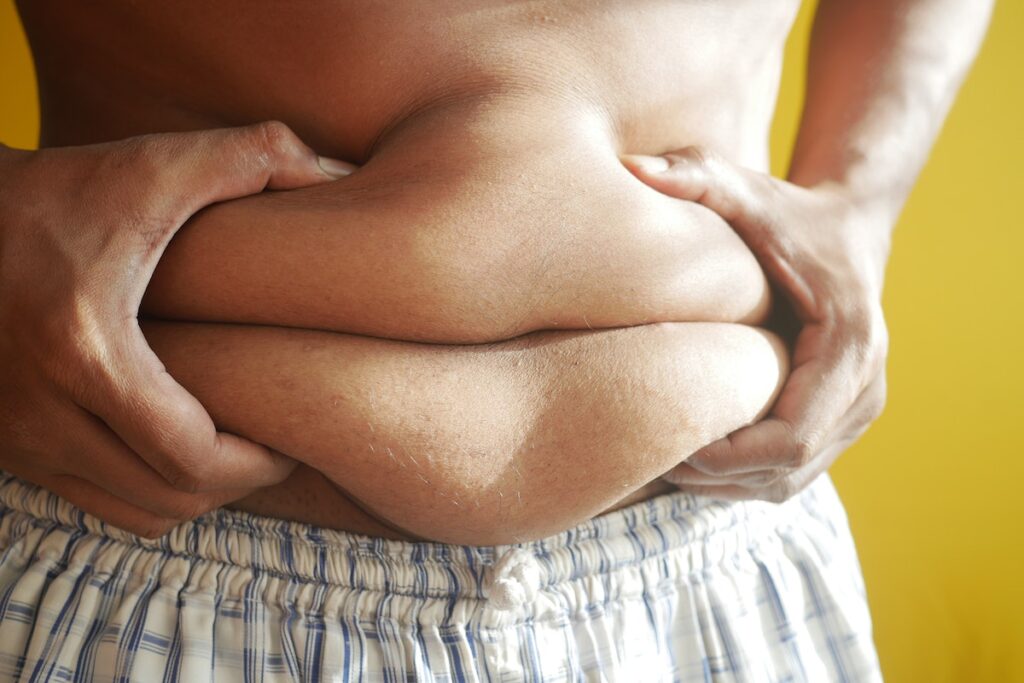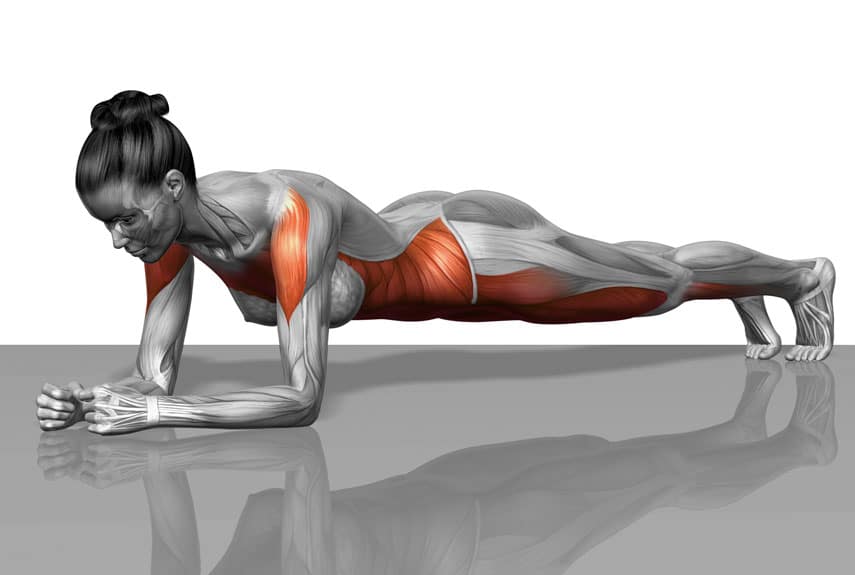
Do you feel bothered by that stubborn belly fat hanging over your waistline? Having an apron belly, often referred to medically as a ‘pannus stomach’, can be a source of discomfort and frustration for many. This extra layer of fat is tricky to deal with, and it often seems to stick around no matter what you try.
In this article
- What is an apron belly?
- What causes an apron belly?
- Will losing weight get rid of a hanging belly?
- How can you reduce or get rid of an apron belly without surgery?
- How can you address an apron belly from pregnancy?
- What about an apron belly due to rapid weight loss?
- What are the health consequences of having extra belly fat?
- How long does it take to get rid of an apron belly or hanging belly?
- When to Consider Consulting with Plastic Surgeons
- Frequently asked questions (FAQ)
- Final Word
While surgical options like a tummy tuck are popular for effectively dealing with this issue by removing the pannus, many individuals seek ways to reduce or remove their apron belly without undergoing surgery. Let’s explore the non-surgical avenues that may help manage or reduce an apron belly.
What is an apron belly?
An apron belly, also known as a panniculus or mother’s apron, is a mass of tissue that hangs down from the stomach, much like an apron. It can extend from the pubic area to as far as the knees and beyond, causing significant life disruption. In some cases, it can weigh more than 50 pounds, adding to the physical discomfort and health risks associated with it.
This skin and tissue that hangs can sometimes interfere with daily activities and hygiene. Keeping the area clean and dry is crucial to prevent irritation and other skin issues.
What causes an apron belly?
An apron belly results from significant fat deposits and possibly excess skin that accumulates around the lower abdomen. It can be caused by a variety of factors. Two of the most common are pregnancy and significant weight gain. During these times, the abdominal skin stretches and fat cells expand, leading to an apron-like flap of tissue that hangs down.
However, it’s not just women or those who are overweight who can develop an apron belly. It can also occur in men and those who have lost a significant amount of weight, as the excess skin from their previous weight can hang down, forming an apron belly.
Obesity is a primary contributing factor to the accumulation of excess fat in the abdominal area, which can lead to an apron belly. The condition can increase the risk of various chronic diseases, including cancer, heart disease, and type 2 diabetes.
Will losing weight get rid of a hanging belly?
Losing weight can indeed help reduce a hanging belly, but let’s dig into the specifics. When we talk about “weight loss,” we’re typically referring to a reduction in both body fat and lean muscle mass. But in the context of a hanging belly, our primary concern is body fat.
Now, the idea of targeted fat loss, also known as spot reduction, has been largely debunked by research. You can’t exclusively lose fat from just your belly by doing endless crunches. However, reducing your overall body fat percentage will certainly help.

A comprehensive approach to weight loss—incorporating a balanced diet, regular exercise, and a healthy lifestyle—can effectively decrease your body fat percentage, including the fat stored in your belly.
For instance, consider the example of a client I worked with named Alex. He had been struggling with a hanging belly for years despite regular exercise. When we started working together, we shifted focus from just exercise to a holistic approach: balanced nutrition, resistance, and cardiovascular training, and healthy sleep patterns. Over six months, Alex saw a significant reduction in his hanging belly, largely due to the decrease in his overall body fat percentage.
How can you reduce or get rid of an apron belly without surgery?
While I did mention this earlier, I believe it’s worth repeating: spot reduction, or losing fat from one specific area, is not viable. Instead, aim for overall body fat reduction for a healthier body and a flat belly. Here are some effective strategies that can help:
- Implement a balanced, nutrient-dense diet: Consuming a well-rounded diet rich in fruits, vegetables, lean proteins, and whole grains helps in overall fat loss. Reducing the intake of processed foods, sugars, and saturated fats also aids in maintaining a healthy weight.
- Increase physical activity: Regular exercise is crucial. Aim for at least 150 minutes of moderate aerobic activity or 75 minutes of vigorous activity each week, as suggested by the Centers for Disease Control and Prevention (CDC). This could be anything from brisk walking to high-intensity interval training (HIIT).
- Strength training: Strength training exercises that target multiple muscle groups can help reduce body fat and build lean muscle. This isn’t just about abdominal exercises, but workouts that engage the entire body. The American Heart Association recommends strength training at least two days per week.
- Focus on core strengthening: Core exercises not only strengthen the abdominal muscles but also the muscles of the back and pelvis. Strong core muscles can lead to improved posture, which may make an apron belly less noticeable.
- Manage stress: Chronic stress can lead to weight gain and fat storage in the abdominal area due to increased cortisol levels. Techniques such as yoga, meditation, and deep-breathing exercises can help manage stress levels.
How can you address an apron belly from pregnancy?
An apron belly or ‘postpartum belly’ often appears following pregnancy. This condition arises due to the natural expansion and stretching of the skin and abdominal muscles, necessary to accommodate a growing baby during pregnancy. It’s crucial to remember that this is a normal part of the body’s response to childbirth, and several strategies can aid in managing these postpartum changes.
1. Postnatal Exercise
Initiating a postnatal exercise regimen, as soon as your doctor gives the all-clear, is a beneficial first step. Starting with gentle activities, such as walking and pelvic floor exercises like Kegels, can help your body gradually readjust. As your strength returns, you can slowly introduce more targeted exercises into your routine. You can include postnatal yoga or pilates, which offer numerous benefits for a postpartum body.
2. Core Strengthening
As your recovery progresses, workouts that focus specifically on core strengthening can be particularly beneficial. It’s crucial, however, to avoid intense abdominal exercises until your doctor gives the approval. This is to avoid worsening certain postpartum conditions such as diastasis recti, which is the partial or complete separation of the rectus abdominis or “six-pack” muscles.

3. Breastfeeding
Breastfeeding, if you choose and are able to do so, can also aid postpartum weight loss. This natural process helps in shrinking the uterus back to its pre-pregnancy size and can contribute to burning additional calories.
4. Hydration and Nutrition
Another critical aspect of postpartum recovery is maintaining proper hydration and nutrition. A diet rich in nutrients can not only boost your energy levels but also support your overall recovery and contribute to the health of your skin. Including fruits, vegetables, lean proteins, and whole grains in your meals can offer a balanced array of essential nutrients.
5. Compression Garments
Lastly, while they won’t directly reduce an apron belly, postpartum compression garments can provide both comfort and support during the recovery period. These specially designed garments can assist in helping your body gradually return to its pre-pregnancy shape. While the journey of postpartum recovery can be challenging, these strategies can support and enhance your body’s natural healing process.
What about an apron belly due to rapid weight loss?
An apron belly that results from rapid weight loss can present a unique challenge. This typically occurs when the skin and tissues lack the necessary elasticity to conform to the reduced body size. While this can seem daunting, there are strategies you can adopt:
- Strength training: Building lean muscle mass can help fill out some of the loose skin and improve your overall body composition. Full-body workouts can help you build muscle mass evenly across your body.
- Hydration and nutrition: Staying well-hydrated and maintaining a balanced diet can contribute to skin health. Foods rich in vitamins C and E, selenium, and other antioxidants can aid in skin elasticity.
- Skin firming creams: While these won’t provide a dramatic improvement, some creams and lotions can slightly improve skin elasticity. Look for products containing ingredients like retinoid or hyaluronic acid.
- Non-surgical treatments: There are also a variety of non-invasive procedures that can help tighten and lift loose skin. These include laser treatments, ultrasound, radiofrequency, and IPL (Intense Pulsed Light) treatments.
What are the health consequences of having extra belly fat?
Excess belly fat, particularly when it’s stored around your abdomen, can be more than just a cosmetic concern. This type of fat is called visceral fat, and it differs from the subcutaneous fat that lies just under your skin. Visceral fat surrounds your internal organs, and it’s associated with several significant health risks:
- Heart Disease: Research has shown a strong link between abdominal fat and heart conditions like coronary artery disease. This is because visceral fat can contribute to the development of atherosclerosis, which is the hardening and narrowing of the arteries due to plaque build-up.
- Type 2 Diabetes: Visceral fat is metabolically active and can affect your body’s insulin resistance. This means your body’s ability to regulate blood sugar can be impaired. Over time, this can increase your risk of developing type 2 diabetes.
- Certain Cancers: There’s evidence to suggest that people with a larger amount of belly fat have a higher risk of developing certain cancers, including breast cancer and colorectal cancer.
- Sleep Apnea: Excess belly fat can interfere with your breathing, making sleep apnea more likely. Sleep apnea is a potentially serious sleep disorder where breathing repeatedly stops and starts during sleep.
- Metabolic Syndrome: This is a cluster of conditions, including high blood pressure, high blood sugar, abnormal cholesterol levels, and excess abdominal fat, that occur together, increasing your risk of heart disease, stroke, and type 2 diabetes.
How long does it take to get rid of an apron belly or hanging belly?
The timeline for reducing an apron belly or hanging belly is different for everyone. It depends on factors such as your starting point, weight loss approach, lifestyle habits, individual factors, and skin elasticity.
In general, it’s recommended to aim for a gradual and sustainable weight loss of 1-2 pounds per week. This can help minimize muscle loss and allow your skin to adapt gradually. It’s important to be patient and stay committed to following a balanced diet and engaging in regular exercise.
When to Consider Consulting with Plastic Surgeons
While the above methods can help manage the symptoms of an apron belly, they do not provide a permanent solution, particularly when there’s substantial excess skin and fat. Plastic surgeons offer several surgical options for those looking to permanently remove an apron belly.
A consultation with a specialist can provide insights into procedures like abdominoplasty (tummy tuck). This procedure removes excess skin and fat and tightens the abdominal wall. It is typically recommended for those who have not achieved desired results through lifestyle changes or for whom the pannus causes significant physical or hygienic issues.
Frequently asked questions (FAQ)
Got more questions about how to get rid of an apron belly without surgery? Check out some commonly asked questions about this topic below.
What kind of exercises are most effective for reducing apron belly?
Exercises that target the core muscles, such as planks, sit-ups, and leg raises, can help tone the abdominal area. This in turn reduces the appearance of an apron belly. Cardiovascular exercises like running, swimming, or cycling can also help burn overall body fat.
How can dietary changes help in reducing apron belly?
A balanced diet plays a significant role in managing weight and reducing body fat, including apron belly. Eating a diet rich in lean proteins, fruits, vegetables, and whole grains can help reduce overall body fat. Try to limit the intake of processed foods, sugary drinks, and alcohol. Remember, it’s not just about reducing calories but eating nutrient-dense foods that keep you feeling satisfied and energized.
Final Word
So, are you ready to start incorporating these tips to reduce your apron belly without surgery? Remember, it’s all about adopting a healthy lifestyle, which includes a balanced diet, regular exercise, and positive lifestyle changes. With patience and persistence, you can make a real difference.
Feel like this article could make a difference to someone you know? Go ahead and share it with them! And don’t forget to explore the rest of my blog for more tips and guidance on healthy living and fitness.
